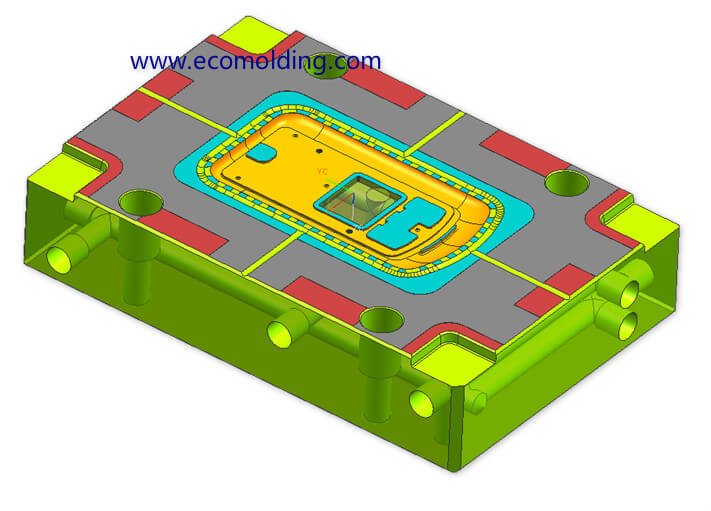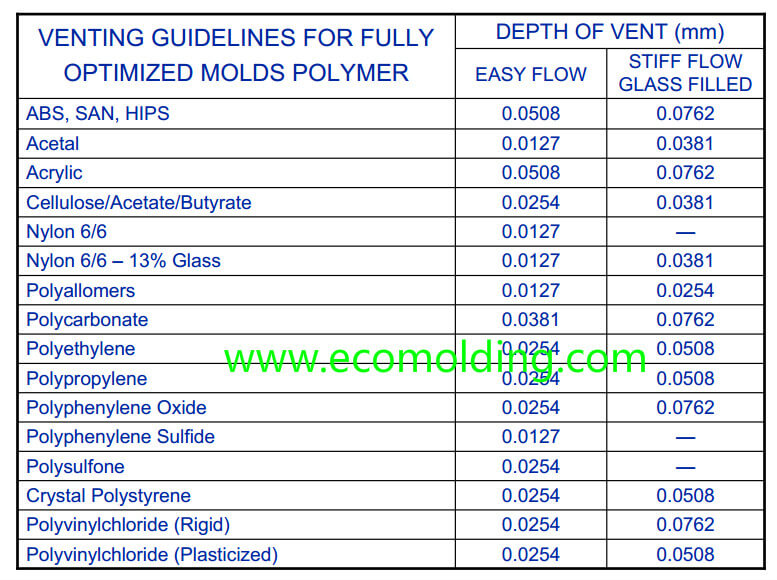During the plastic injection mold trial process, defects like short-filling, trapped air burns, high internal stress, flow marks and weld lines often occur. For those problems, the first solution would be adjustment of the plastic injection molding process, and another consideration would be the reasonable design of the mold gate. Once both of these problems are solved, the possible trouble could mainly lie in injection mold venting, to which the main solution would be the design of venting slots.

The Function & Design of Injection molding Venting
1. The Functions of Injection Mold Venting
A venting slot mainly serves 2 purposes, 1) Removing air from the mold cavity during the injection molding process; 2) removing the various gases produced during the material heating process. Venting slots are of great importance especially to thin-walled products as well as the locations far from the gate. Besides, venting slots also very important for small size or precision parts, because in addition to preventing product surface burns and short filling, they eliminate various product defects and reduce mold contamination. So, what is sufficient air venting for a plastic mold? Generally speaking, when there are no burn marks on product surface at the highest injection speed, the venting effect of the mold cavity would be considered sufficient.
2. Venting Methods
There are many ways to vent the mold cavity, but each has to guarantee that: first, the dimensional design is able to prevent material from entering the slot during the venting process; second, it is able to prevent clogging at the same time. Therefore, for the 6 – 12mm long or above (measuring from the inner surface of the cavity to the outer edge of the mold cavity) slot portion, the height has to be increased by 0.25 – 0.4mm. Besides, it would be harmful if there are too many venting slots, because if the clamping force applied on the unslotted area of the cavity parting surface is too high, cold material flow in the cavity or cracking would occur, which is very dangerous. In addition to venting the mold cavity from the parting surface, the venting purpose can also be achieved by machining venting slots at the melt flow end in the gating system, as well as leaving venting clearance around the ejector pin. The depth, width and location of the venting slots play an important role in defining product quality – flash will occur if not appropriately designed. As a result, the size of the above-mention clearance should be able to prevent flash occurring around the ejector pin. It should be specially noted that: when designing venting for parts like gears, even the slightest flash is not allowed. So, the following venting methods should be adopted for such parts: ① thoroughly remove air in the runner; ② apply shot peening treatment to the parting surface with the 200# silicon carbide abrasives. Besides, setting up venting slots at the melt flow end in the gating system mainly refers to the venting slots at end of the branch runners, of which the width should be equivalent to that of the branch runner while the height varies with materials.
3. Design Approach
Based on many years of experience in injection mold design and mold trial, this article simply introduces the designs of several types of venting slots, as shown in figure 1. With regard to the mold for production of complicated shaped products, venting slot setup should better be determined after several rounds of mold trials. Among all mold structural designs, the integral structure features the poorest venting effect. The following venting methods can be applied for integral cores/cavities: ① make use of the slot or insert location in the mold cavity; ② make use of the lateral insert crevice; ③ design local area into a spiral; ④ mount the batten horizontally and set up technological holes; ⑤ when it is extremely difficult to expel the air out of the mold, an insert should be adopted. If it is not easy to machine a vent slot in some locations of a mold, such as in the corners, the insert molding process may be appropriately applied on condition that product appearance and precision are not affected. This method not only helps with venting, but is also able to lower the difficulty level for machining, and convenient for maintenance.

Conclusion
Properly designed venting slots are able to remarkably reduce injection pressure, injection time, pressure holding time and clamping force, thus making the plastic injection molding process a lot easier by improving production efficiency, lowering production costs and reducing machine energy consumption.
